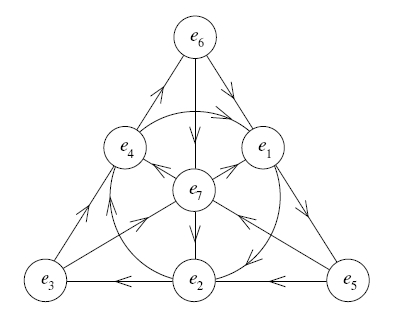3d Rotations and the 7d Cross Product (Part 1)
Posted by John Baez
There’s a dot product and cross product of vectors in 3 dimensions. But there’s also a dot product and cross product in 7 dimensions obeying a lot of the same identities! There’s nothing really like this in other dimensions.
The following stuff is well-known: the group of linear transformations of preserving the dot and cross product is called . It consists of rotations. We say has an ‘irreducible representation’ on because there’s no linear subspace of that’s mapped to itself by every transformation in , except for and the whole space.
Ho hum. But here’s something more surprising: it seems that also has an irreducible representation on where every transformation preserves the dot product and cross product in 7 dimensions!
That’s right—no typo there. There is not an irreducible representation of on that preserves the dot product and cross product. Preserving the dot product is easy. But the cross product in 7 dimensions is a strange thing that breaks rotation symmetry.
There is, apparently, an irreducible representation of the much smaller group on that preserves the dot and cross product. But I only know this because people say Dynkin proved it! More technically, it seems Dynkin said there’s an subgroup of for which the irreducible representation of on remains irreducible when restricted to this subgroup. I want to see one explicitly.
We can get the dot and cross product in 3 dimensions by taking the space of imaginary quaternions, which is 3 dimensional, and defining
The multiplication on the right-hand side of these formulas is the usual quaternion product.
We can get the dot and cross product in 7 dimensions using formulas that look just the same! But we start with the space of imaginary octonions, which is 7 dimensional, and we use the octonion product.
In both cases we get a ‘vector product algebra’. A vector product algebra is a finite-dimensional real vector space with an inner product I’ll call the dot product and denote by
together with a bilinear operation I’ll call the cross product
obeying three identities:
These imply a bunch more identities.
You can get a vector product algebra from a normed division algebra by taking the subspace of imaginary elements, namely those orthogonal to , and defining a dot and cross product using the formulas above. You can also reverse this process. Since there are only four normed division algebras, and , there are only four vector product algebras! But you can also run this argument backwards, which is nice because there’s a great string diagram proof that there are only four vector product algebras:
Markus Rost, On vector product algebras.
Ross Street, Vector product and composition algebras in braided monoidal additive categories.
The four vector product algebras have dimensions 0, 1, 3, and 7. But only the last two are interesting, since in the first two the cross product is zero.
In fact the category of normed division algebras and algebra homomorphisms (which automatically preserve the inner product these algebras have) is equivalent to the category of vector product algebras. Thus the group of automorphisms of the 7-dimensional vector product algebra is isomorphic to the group of automorphisms of . This group is called .
Recently on Mastodon Paul Schwahn wrote:
The compact Lie group , usually defined as automorphism group of the octonion algebra , has (up to conjugacy) three maximal connected subgroups:
- the subgroup preserving the algebra of quaternions which is isomorphic to ,
- the subgroup preserving some imaginary element like , which is isomorphic to
- the subgroup given by the image of the irreducible, faithful 7-dimensional real representation of . This representation may be realized as the space of harmonic cubic homogeneous polynomials on or if you are a chemist, the space of -orbital wavefunctions.
Now I wonder whether also has some interpretation in terms of the octonions. What irreducible action of on the imaginary octonions is there?
@johncarlosbaez, do you perhaps have an idea?
Alas, I’m a bit stuck!
I know the compact Lie group acts irreducibly on the 7-dimensional space of imaginary octonions. In fact it’s precisely the group of linear transformations that preserves cross product on , and all these automatically preserve the dot product (by the argument here).
But I don’t know a concrete example of an subgroup of that acts irreducibly on . Apparently they’re all conjugate, so we can pick any one and call it . Can anyone here describe one concretely?
I do know how to get to act irreducibly on a 7-dimensional space. It’s called the spin-3 representation of , or more precisely it’s the real form of that. Up to isomorphism this is the only irreducible representation of on a 7d real vector space, so the representation of on must be this.
There may be an explicit description of in here:
- E. B. Dynkin, Semisimple subalgebras of semisimple Lie algebras, American Mathematical Society Translations, Series 2, Volume 6, 1957.
But I haven’t dug into this text yet. I’ll try. But if you happen to know such an explicit description, please tell me!


Re: 3d Rotations and the Cross Product in 7 Dimensions
We need Robert Bryant to turn up and answer your question about the in …